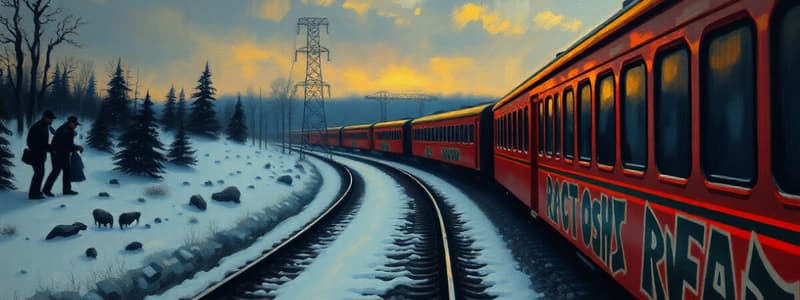Podcast
Questions and Answers
The Trans-Siberian Railroad is the world's longest railway.
The Trans-Siberian Railroad is the world's longest railway.
True (A)
The Trans-Siberian Railway spans approximately 5,707 kilometers.
The Trans-Siberian Railway spans approximately 5,707 kilometers.
False (B)
The Trans-Siberian Railroad connects Moscow to Beijing.
The Trans-Siberian Railroad connects Moscow to Beijing.
False (B)
The design speed of the Trans-Siberian Railway is 80 kilometers per hour.
The design speed of the Trans-Siberian Railway is 80 kilometers per hour.
The Trans-Siberian Railroad crosses twelve time zones during its journey.
The Trans-Siberian Railroad crosses twelve time zones during its journey.
Flashcards
Trans-Siberian Railroad
Trans-Siberian Railroad
The world's longest railway, spanning approximately 5,707 miles from Moscow to Vladivostok.
Significance of the Railroad
Significance of the Railroad
Connects European rail networks with Chinese rail networks or Vladivostok, double-tracked and electrified.
Trans-Siberian Route
Trans-Siberian Route
Moscow to Vladivostok.
Lake Baikal
Lake Baikal
Signup and view all the flashcards
Ulaanbaatar
Ulaanbaatar
Signup and view all the flashcards
Study Notes
- The Trans-Siberian Railroad is the world's longest railway, attracting travelers to witness an engineering marvel and experience a unique journey
- The railway spans approximately 5,707 miles
- It stretches from Moscow in Europe to Vladivostok on the Pacific Ocean
Construction and Significance
- Built between 1891 and 1916
- Formerly considered a prized asset of the Russian Empire
- It is double-tracked and electrified
- It connects European rail networks with Chinese rail networks or Vladivostok
Route and Travel
- The railroad crosses seven time zones during its journey
- It passes through over 30 cities, including those in Siberia and the Russian Far East
- A non-stop trip from Moscow to Vladivostok takes seven days
- The design speed is 80 kilometers per hour
Branch Lines
- The main line branches into three routes from Ulan-Ude
- Moscow to Vladivostok is the Trans-Siberian route
- Moscow to Beijing (via Ulaanbaatar, Mongolia) is the Trans-Mongolian route
- Siberia to Beijing (via Manchuria) is the Trans-Manchurian route
Travel Tips
- Regular trains are commonly used by locals for commuting, offering a chance to interact with the people and experience the country's culture
- Key termini include Moscow, Beijing, and Vladivostok
- Moscow is accessible by train from major European cities like Amsterdam, London, Paris, and Berlin
- Beijing connects to Asian cities such as Guangzhou, Hong Kong, and Bangkok
- Vladivostok can be reached by ferries from Fushiki (Japan), Donghae, and Sakcho (South Korea)
- Travelers typically need visas for Russia, China, and Mongolia
Scenery and Experience
- The journey offers diverse scenery, from Moscow to Siberia and Vladivostok
- Landscapes include Lake Baikal, the Ural Mountains, plains, grasslands, and pine forests
- Travelers can experience Russian cuisine in cities and villages and meet both local and international passengers
- The 9288 km monument at the Vladivostok station is a notable landmark
- For city exploration, purchasing separate tickets for each stopover is recommended due to limited stop times (max. 20 minutes)
Recommended Stopovers
- Lake Baikal is the world's largest freshwater lake (by volume), containing over 22% of the world's fresh water
- Ulaanbaatar is the capital of Mongolia, accessible via the Trans-Mongolian Railway
Overall Experience
- Provides a view of Russia's diverse landscapes, from cities to remote villages
- The scenery transitions from the Ural Mountains to Lake Baikal
Studying That Suits You
Use AI to generate personalized quizzes and flashcards to suit your learning preferences.




